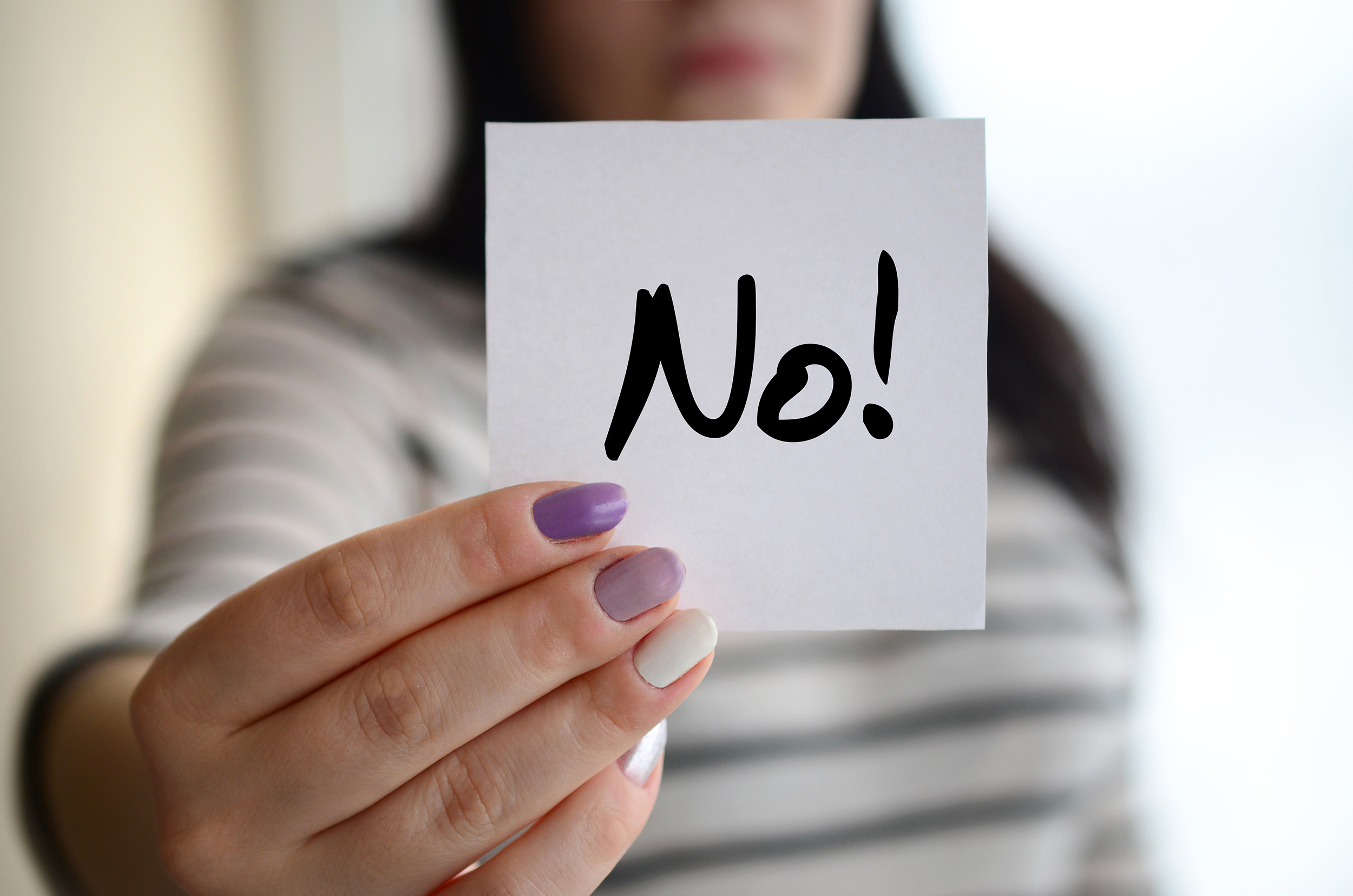
Rylee Lueken
November 3, 2025
•
8 min read time
Learn how to set boundaries, say no confidently, and protect your mental health with practical strategies that actually work.
Ever found yourself saying "yes" when every part of you wanted to say "no"? Maybe you took on an extra shift you didn't want, agreed to hang out even though you were wiped, or listened to someone vent when you had zero emotional energy left.
It happens to all of us. But when saying yes becomes a habit, it drains your energy, steals your peace, and slowly builds up resentment.
This guide is your quick guide to saying no without feeling guilty. We'll cover why setting boundaries feels so hard, how to actually do it, and why mastering this skill is one of the best things you can do for your mental health.
Let's be real, learning how to say no can feel terrifying. Mostly because we're worried about what comes next. Will someone get mad? Think less of us? Will it start drama?
A lot of people say yes just to keep the peace or avoid awkward tension. Others do it because they want approval, or because they've been taught that helping everyone else is the "right" thing to do.
But putting other people's needs before your own all the time? That's a direct path to burnout.
Setting healthy boundaries is a form of self-respect. It means recognizing your time, energy, and emotional bandwidth are limited and it's okay to protect them. When you recognize your own needs, you show others how to value your time as well. This creates more room in your life for the people, activities, and goals that truly matter to you.

Healthy boundaries help other people understand how to treat you. When you communicate your limits clearly, it sets a tone of mutual respect. Strong boundaries also make relationships more genuine because they are based on openness and trust rather than silent resentment.
Always saying yes, especially when something doesn't match your goals or values, leads to regret later. Learning to say no more often helps you stay aligned with what actually matters and avoid running yourself into the ground. By protecting your time and energy, you can bring your best self to the commitments you choose to keep.
Sometimes your body knows before your brain does. If a request instantly makes you feel anxious, resentful, or just plain exhausted, that's a signal.
You can also check in with questions like:
Learning to tune into your own red flags can help you avoid overcommitting and stay grounded in your values.
Express yourself clearly without being harsh. Honesty with respect goes a long way when setting boundaries.
When you're clear about what's okay and what's not, it's easier to speak up before resentment sets in.
Having regular time for yourself—whether that's rest, journaling, or movement—helps you feel more confident when setting boundaries.
Saying things like "I need a break" instead of blaming the other person keeps things calm and avoids unnecessary drama.
Practice saying no in smaller situations (like skipping a casual event) to build your confidence.

If you want to help but can't fully commit, offer a smaller or different option.
You don't have to give an answer on the spot. A simple "Can I get back to you?" buys time and gives space to check in with yourself.
Yes, it might feel awkward at first. But the more you practice, the more you stretch your comfort zone and learn it's totally survivable.
Learning to say no isn't rude or selfish—it's healthy. Showing yourself some compassion makes the whole process easier.
Whether it's a friend, therapist, or a mental health app like Brightn, having backup helps you develop boundary-setting skills.
Here are simple, effective phrases to keep in your back pocket:
You don't need to explain yourself unless you want to. A clear and respectful no is enough.
Not everyone's going to love your boundaries, and that's okay.
Sometimes saying no upsets people, especially if they're used to you always saying yes. But this tension is often temporary. In strong relationships, things bounce back. In toxic ones, the pushback might reveal that your boundaries were long overdue.
Your job isn't to manage everyone's feelings. It's to stay rooted in what's right for you.
Learning to say no takes practice, and Brightn's designed specifically to support this journey:
Guided Journaling Prompts: Work through moments when you felt pressured to say yes. Get guided reflections that help you figure out what's really driving your decisions.
Mood and Energy Tracking: Track your stress and energy levels to see how boundary-setting affects your mental wellness. Your Brightn Zone data makes it easy to spot patterns.
Goal Setting and Check-ins: Set specific goals like "Say no once this week" or "Protect one evening for rest." Use Brightn's flexible check-ins to stay accountable.
Personal Purpose Alignment: Let your Unique Life Statement (ULS) guide your decisions. If something doesn't align with your ULS, it's an easier no.
Download Brightn today to start building stronger boundaries with tools designed by mental health experts.

Guilt is normal—but it doesn't mean you did something wrong. It's just your brain adjusting to a new pattern. Keep practicing and the guilt will fade.
You're allowed to disappoint people. That doesn't make you a bad person. If someone can't handle your reasonable limits, that's their issue to work through, not yours.
Absolutely not. "It doesn't work for me" is a complete answer. If you want to explain, go for it, but you're never obligated to justify your boundaries.
Like any skill, it improves with practice. Most people notice increased confidence within a few weeks of consistently practicing boundary-setting in low-stakes situations.
Yes, but be thoughtful about it. Constantly changing boundaries can confuse others and undermine your credibility. Make sure you're not just reverting due to guilt or pressure.
Family boundaries can be trickier because of emotional history and expectations. Start with clear, kind communication about your needs and be prepared for some initial resistance.
Setting healthy boundaries isn't just about saying no—it's about creating space for what matters most to you. When you protect your time, energy, and emotional well-being, you're investing in better relationships, reduced stress, and authentic self-care.
Ready to start your boundary-setting journey? Download Brightn and access expert-designed tools that make learning to say no easier and more sustainable.

Scott, E., PhD. (2023, December 6). How to Say No to People. Verywell Mind. https://www.verywellmind.com/say-no-to-people-making-demands-on-your-time-3145025
Donald, J. N., et al. (2018). Autonomy, guilt, and emotional well-being. In PositivePsychology.com. https://positivepsychology.com/how-to-say-no/
Holmes, T. (2016). Assertiveness and boundary setting skills. In PositivePsychology.com. https://positivepsychology.com/assertiveness-skills/
Muris, P., & Otgaar, H. (2023). Self-compassion and psychological health. In PositivePsychology.com. https://positivepsychology.com/self-compassion/
Tawwab, N. (2021). Set Boundaries, Find Peace. New York: TarcherPerigee.
Reid, S., & Smith, M. A. (n.d.). Setting Healthy Boundaries in Relationships. HelpGuide.org. https://www.helpguide.org/relationships/social-connection/relationship-help
PositivePsychology.com. (n.d.). How to say no: Why it's hard and how to learn. https://positivepsychology.com/how-to-say-no/
PositivePsychology.com. (n.d.). Setting healthy boundaries in relationships. https://positivepsychology.com/great-self-care-setting-healthy-boundaries/